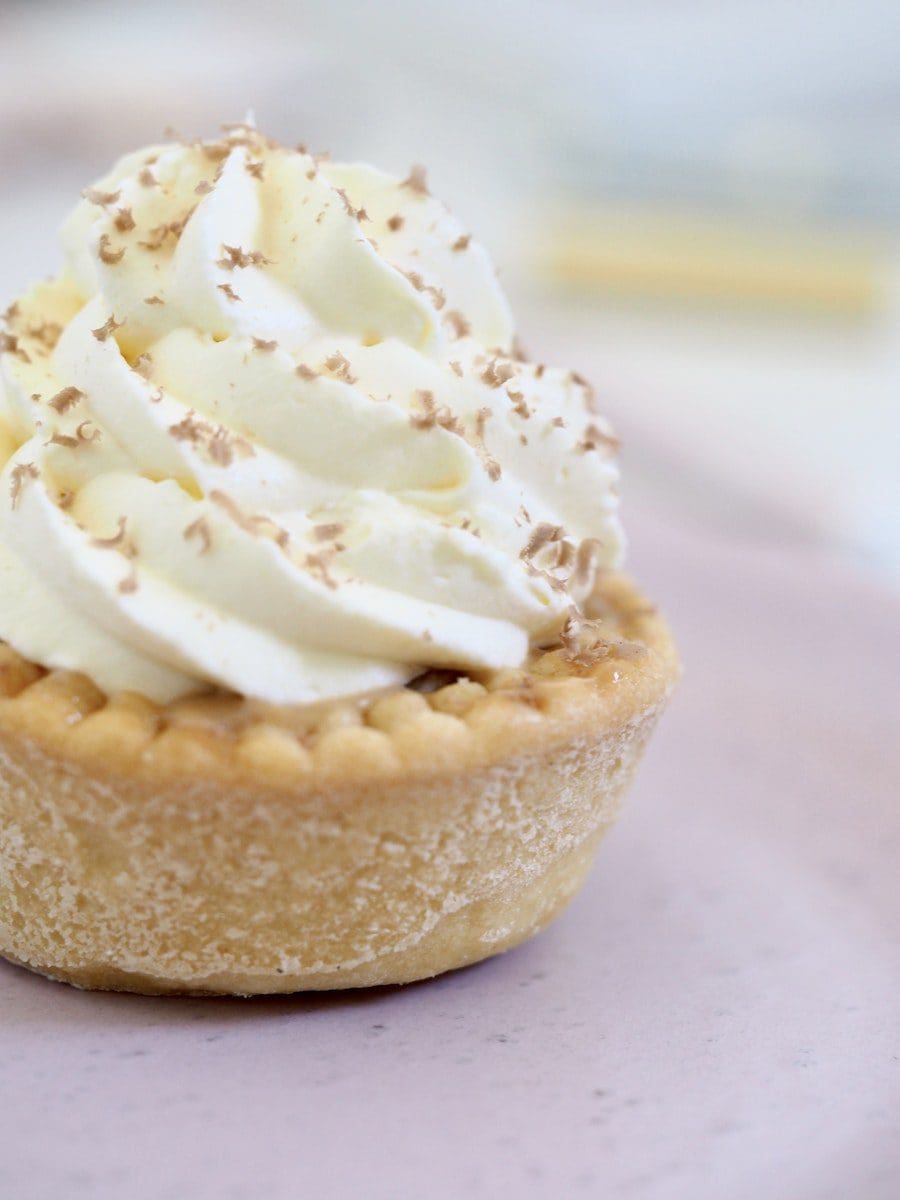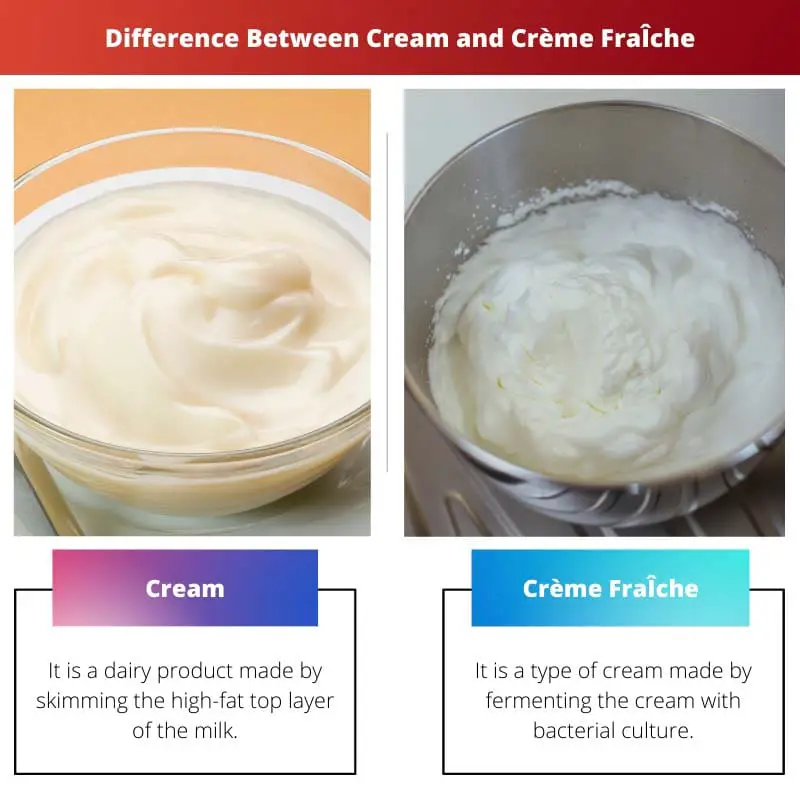Milk has been used by living beings since the beginning of recorded time. Milk and the products made from milk have become an essential part of our daily lives.
These dairy products are used in a wide variety of food items, like cakes, shakes, desserts, etc. Usually, the byproducts of milk contain fat but vary in their concentration of fat. Cream and Crème FraÎche are two such products made out of milk.
Key Takeaways
- Cream is a dairy product with high-fat content, while crème fraîche is a cultured cream product made by adding bacteria to heavy cream.
- Crème fraîche has a thicker consistency and tangier flavor than regular cream, which is lighter and more neutral.
- Cream is better suited for whipped or sweet applications, whereas crème fraîche can be used in sweet and savory dishes and resists curdling when heated.
Cream vs Crème FraÎche
Cream is a rich dairy product that is the higher-fat layer skimmed from the top of milk before homogenization and used as an ingredient in mostly sweet foods. Creme fraiche is cream that has a culture added. It is slightly sour, thicker and creamier in flavour with a lower level of acidity and higher fat content.

The cream is a dairy product that is made from butterfat skimmed from the top layer of milk.
This is done prior to homogenizing the milk. It is the thickness of the Cream that determines whether it can be whipped or not. This Cream is used in various food products, such as ice cream, coffee, etc.
Crème FraÎche falls under the category of creams. It is a type of Cream that is produced after fermenting the Cream with lactobacillus.
This Cream is in some ways similar to sour Cream but is less sour and is comparatively thicker. It is used to add flavour to soups and is also used as a topping for various desserts.
Comparison Table
| Parameters of Comparison | Cream | Crème FraÎche |
|---|---|---|
| Definition | It is a dairy product made by skimming the high-fat top layer of the milk. | It is a type of cream made by fermenting the cream with bacterial culture. |
| Use | It is used to prepare desserts like ice-creams and can be used in beverages like coffee. | It is used to add flavor to soups or to add thickness in broths. It too can be used in desserts. |
| Making | It is made by skimming the layer that appears on top of homogenized milk. | It is made by fermenting the heavy cream, so a host of bacteria act on it. |
| Thickness | The thickness of the cream depends on the butterfat content present in the layer. | It is thicker than sour cream. |
| Fat content | The thicker creams tend to have higher fat content. | It has a fat content between the range of 10 to 35 percent. |
What is Cream?
The cream is a dairy product that is made of butterfat skimmed from the top layer of the milk before it is homogenized. This top layer is quite rich in fat.
Homogenizing is a process in which the fat droplets are emulsified, after which Cream does not separate from the milk, thereby defeating the purpose.
When the milk is not homogenized, the fat rises to the surface because it is less dense.
Cream industries use “separators” and centrifuges to speed up this process. Different countries sell this Cream, categorizing it in several grades of fat content present.
It is used as a key ingredient in multiple dishes like soups, stews, sauces, etc. Its use in desserts and sweet dishes is popularly known. Light Cream is used as an add-on in coffee in the USA and Canada. It is also used in several Indian curries, such as Paneer dishes.
Based on the fat content, creams can be used to make different varieties of Cream. For example, if the Cream is thick enough, it could be turned into whipped Cream and served as a topping on multiple cuisines. Some other types of Cream include sour Cream, crème FraÎche, etc.

What is Crème FraÎche?
Crème FraÎche is a type of Cream that is made by fermenting heavy Cream. It turns into double Cream when a host of bacteria acts on it. It has a thicker texture when compared to sour cream. It is also less sour. It has fat content ranging between 10 – 45% of butterfat.
It is made by when heavy Cream is added to a starter culture. This means that bacteria are allowed to act upon it. It is left to stand at an appropriate temperature until the mixture starts to thicken.
The bacteria that acts on it changes the taste of the Cream, making it different from other types of Cream.
Crème FraÎche has a thicker and sort of velvety texture. It has a sharp, tangy taste but is less sour than sour cream. This mature kind of Cream is rich and thick. It has a pH value of about 4.5, which makes it slightly acidic.
Translated as fresh Cream, this type of Cream is loved and prepared all over the globe. It has its origin in France and is used both as hot and cold crème in French cuisines.
Its preparation slightly differs in France because there it is made by using unpasteurized milk, whereas, in America, it is made from pasteurized milk. It is used as a base layer for many desserts and as toppings in ice creams and other dishes.

Main Differences Between Cream and Crème Fraiche
- The cream is a broader term used for the skimmed butterfat layer that appears on top of the milk before it is homogenized, whereas Crème FraÎche falls under the broad category of creams.
- Crème FraÎche is made by fermenting heavy Cream and allowing bacteria to work on it, while Cream is simply produced by skimming the top layer that appears on the milk.
- The cream can vary in thickness depending upon the fat content, whereas Crème FraÎche is known for its thickness.
- Crème FraÎche has a pH value of 4.5, which makes it slightly acidic as compared to the natural Cream.
- Crème FraÎche stands out because of its distinct nutty taste, while Cream is not that salty.
- The cream can be of various types based on the fat content present, whereas Crème FraÎche is a kind of Cream that has a fat content range between 10 and 45 percent.

- https://books.google.com/books?hl=en&lr=&id=MnG50g_P0VUC&oi=fnd&pg=PA235&dq=creme+fraiche&ots=ObObf9i_bb&sig=-zG07zsIHVbnIuUHEtG7-_6gtmg
- https://www.researchgate.net/profile/Eliane-Dumay/publication/237950519_Effects_of_High_Pressure_on_the_Physicochemical_Characteristics_of_Dairy_Creams_and_Model_OilWater_Emulsions/links/5a5c7a1aaca2727d608a822b/Effects-of-High-Pressure-on-the-Physicochemical-Characteristics-of-Dairy-Creams-and-Model-Oil-Water-Emulsions.pdf

The comparison between cream and crème fraîche provided here is enlightening, shedding light on these essential dairy products and their uses in cooking.
Yes, the thorough comparison table makes it easier to differentiate between cream and crème fraîche.
Absolutely, this knowledge can contribute to better recipe outcomes and culinary experiences.
This article provides essential knowledge about cream and crème fraîche, allowing readers to understand their roles in various types of dishes and food preparations.
Absolutely, such detailed insights can guide both amateur and professional cooks in creating delightful culinary experiences.
The detailed explanation about cream and crème fraîche is quite insightful, especially for those who are passionate about cooking and experimenting with different flavors and textures.
Absolutely, these insights are enriching and inspiring for culinary enthusiasts.
The comparison between cream and crème fraîche is quite enlightening, offering a comprehensive understanding of their characteristics, uses, and applications.
Absolutely, it’s fascinating to delve into the details of these essential dairy products and their contributions to culinary experiences.
Indeed, this knowledge provides valuable insights for those who enjoy experimenting with various recipes and cooking styles.
I appreciate the detailed information provided about cream and crème fraîche. It’s interesting to learn about their characteristics and applications in various culinary creations.
Absolutely, understanding these differences can help in creating more sophisticated and delightful dishes.
Indeed, these insights can inspire new recipes and culinary experiments.
Understanding the differences between cream and crème fraîche is crucial when it comes to culinary experiments and creating new dishes.
Milk has been an essential part of human diet for a long time, and it’s important to understand its byproducts such as cream and crème fraîche to make the best use of them in various dishes.
I completely agree. It’s fascinating how these byproducts are used so widely in different food items.
The thorough explanation of the differences between cream and crème fraîche is quite informative, providing useful insights for culinary enthusiasts and aspiring chefs.
Absolutely, such knowledge can contribute to the creation of more sophisticated and delightful culinary experiences.
The detailed description of cream and crème fraîche is quite enriching, offering valuable insights for individuals passionate about culinary arts and gastronomy.
Absolutely, such insights can inspire new culinary creations and refining of cooking techniques.
Indeed, understanding the nuances of cream and crème fraîche can elevate one’s cooking skills and recipe developments.
The details about cream and crème fraîche provided here are quite informative. It’s interesting to learn about their differences and applications in cooking.
Absolutely, knowing these details can elevate one’s cooking skills and recipe creations.
Indeed, these insights can enhance the flavors and textures of various dishes.